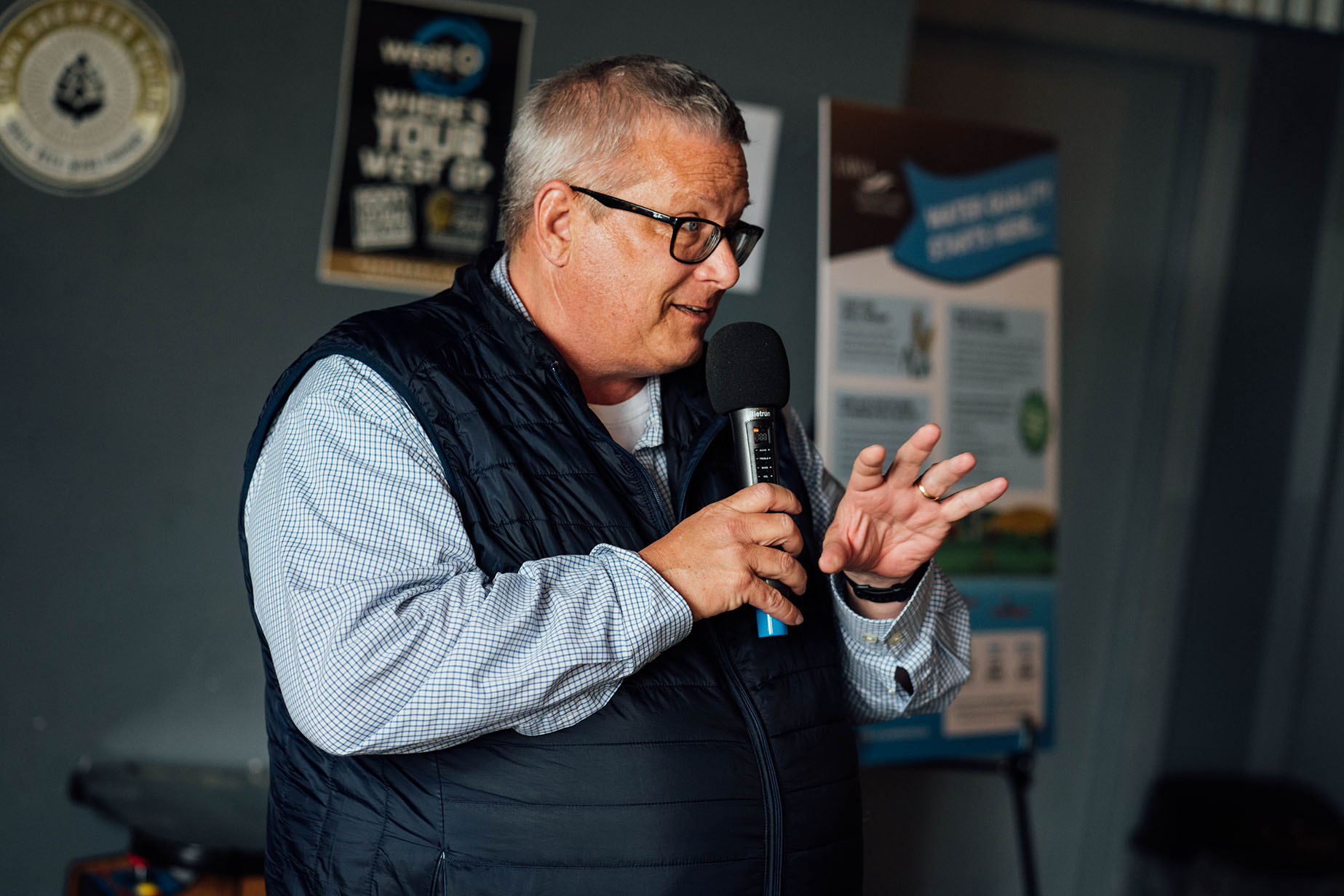
Chuck White shows off his equipment during his field day in Spencer. (Photo credit: Joseph Hopper/Iowa Soybean Association)
Recognizing 10 years of the Nutrient Reduction Strategy
May 18, 2023 | Kriss Nelson
Recognizing 10 years of the Nutrient Reduction Strategy
To help recognize the 10th anniversary of the Iowa Nutrient Reduction Strategy (NRS), this month, the Iowa Agriculture Water Alliance (IAWA) is “Defining a Decade” through a series of field days.
“Ten years ago, with the establishment of the Nitrogen Reduction Strategy, we were given ambitious goals to reduce our phosphorus and nitrogen losses by 45% each,” says IAWA executive director Sean McMahon. “In the first decade, we have nearly implemented our goal for reducing phosphorus loss. That is something to be proud of.”
Last Friday, IAWA teamed up with hosts for the day, Iowa Soybean Association (ISA) District 1 Director Chuck White, at his farm near Spencer and West O Brewery in Milford to share the progress and the continued work needed to achieve the goals set by the INRS a decade ago.
“The Iowa Agriculture Water Alliance has a mission to increase the pace and scale of farmer-led efforts to increase water quality,” says McMahon. “We are just one of 350 organizations partnering to help implement the Iowa Nutrient Reduction Strategy. We have made amazing progress this first decade and there is promise for the next decade to come.”
White farms with his brother and son on their Clay County farms, where they practice no-till, strip-till, raise cover crops and have installed saturated buffers, bioreactors and other edge-of-field practices to do their part to improve soil health and water quality.
“We all try to do things the right way,” White says. “My motto is: Try to do it better every year.”
White says most farmers are doing their best job to improve sustainability and profitability. But he encourages them to do more.
“We all want to do it better, and I encourage farmers to look at these no-till operations because they do work,” he says. “I have seen nothing but success.”

Industry partners
Reducing nutrients couldn’t be possible without ag manufacturers providing the precision equipment required.
Montag Manufacturing has specialized fertilizer placement equipment that continues to grow in popularity and importance because of the INRS.
Anthony Montag, vice president of Montag Manufacturing, says they build fertilizer equipment to help farmers achieve more from their fertilizer investment.
“They can preserve those nutrients from getting into the waterways by making it more available to the crop susceptible to water runoff,” he says.
The company also offers a complete line of equipment to support growers engaging in cover crops.
“Cover crops provide soil stability, significantly enhancing soil health and allowing the farm to hold water and be more resilient,” Montag says.
Adam Herges, senior sustainability agronomist for the Mosaic Company, marketer and manufacturer of phosphate and potash fertilizer, says his company advocate for 4R stewardship: Right fertilizer source at the right rate, right time, and in the right place.
Seeing 4R stewardship implemented on White’s farm was important to Herges.
“It’s important to witness families like the Whites and all the innovation and cutting-edge work they are doing,” says Herges.
Like Montag Manufacturing, the Mosaic Company serves on the IAWA business council.
“We all play a role in water quality,” he says. “We all need to work together to make sure we continue on the progress we have made, which includes 98% completion of phosphorus goals in Iowa.”
Continued partnerships
Beyond industry partnerships are those made on the state and federal levels to help meet NRS goals.
Susan Kozak, division director for Soil Conservation and Water Quality at the Iowa Department of Agriculture and Land Stewardship (IDALS), says partnerships help farmers implement standards set by the INRS. The partnerships between IDALS, ISA, IAWA and the Natural Resources Conservation Service (NRCS) are a few examples of collaborations that help farmers make progress on their farm.
“We can’t do our work without all the partners pulling in the same direction,” she says.
Helping to fund conservation and environmental stewardship has been a part of IDALS for 50 years, as 2023 marks the 50th anniversary of cost-share for those practices in Iowa.
“That is a huge commitment of conservation the state has had for a long time,” she says. “The Nutrient Reduction Strategy has only been around for ten years. We are just getting started.”
There has been tremendous progress, however, at IDALS.
“Ten years ago, we didn’t have dedicated staff for water quality efforts. Now we have 20 people across the state. We have doubled our budget for our division in the last ten years. We have dedicated money for water quality, which is very important for us to have predictable funding to do this work,” says Kozak.
Kozak also recognized the work farmers and landowners have done.
“We have been tripling numbers of saturated buffers and bioreactors,” she says. “A few years ago, we only had a handful of those across the state, and now we have hundreds going in each year.”

Bill Northey, past Iowa Secretary of Agriculture and USDA Under Secretary, is one of the original architects of the INRS.
Currently serving as CEO of the Agribusiness Association of Iowa, Northey credited associations like ISA for work being done further the efforts in the state.
“The Iowa Soybean Association has always been a super strong leader on environmental issues and working with farmers to encourage conservation practices on their land,” says Northey. “This helped to coalesce around water quality with the idea we needed to bring technology and dollars for cost share.”
One area Northey says he is excited about is the inclusion of conservation agronomists.
“So many farmers are interested in figuring out these technologies and how it works on their farm,” he says. “We need these individuals to make that happen to help us progress over the next 20, 30 years.”
Moving forward
Although there has been progress in reducing phosphorus losses, farmers are just scratching the surface regarding nitrogen.
“While we are not satisfied with the amount of nitrogen load reduction so far, we have hit the inflection point,” says McMahon. “We are about to make even more progress in implementing the Nutrient Reduction Strategy in the next decade. While the first decade was a defining decade, we will go even further. The best is yet to come.”
Back